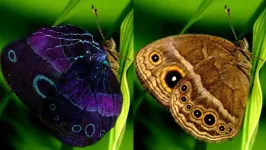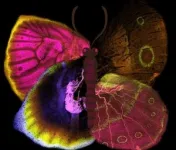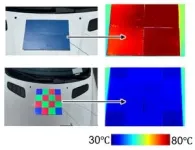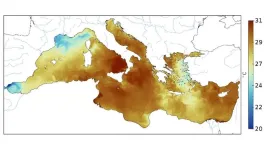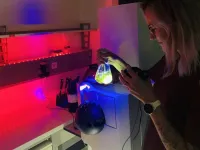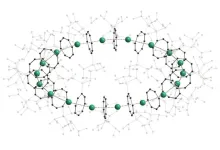(Press-News.org) Wnt signalling is a well-known mode of cell-to-cell communication in multicellular biological organisms. It involves the secretion of small Wnt glycoproteins, by signalling cells, that bind to receptor proteins in the membrane of receiving cells. This signal modifies proteins on the inside of these receiving cells to make cells grow, divide or differentiate. This mode of communication is fundamental in both normal and altered cellular development, such as in cancer and wound healing, and has remained in the limelight for over four decades of research. Some of the open research questions revolve around the extraordinary complexity in the number of Wnt pathway members, functioning both inside, outside, and at the surface of cells, and how different outputs of the pathway are achieved via the use of specific members.
A team of scientists, led by Professor Antónia Monteiro from the Department of Biological Sciences at the National University of Singapore’s (NUS) Faculty of Science, has uncovered some of this complexity by using butterfly wings as a model system. Butterfly wings function as a large two-dimensional (2D) canvas of cells that talk to each other during development to pattern exquisite and detailed colour patterns. They are, thus, exceptional systems to explore the role and diversity of Wnt signalling in such patterning mechanisms. This includes exploring where different elements of the signalling pathway are present, what function they are playing in those cells, and how they are likely to interact with each other.
Using state-of-the-art in-situ localisation technologies, the researchers have deciphered the expression patterns of all eight Wnt glycoproteins, and all four membrane receptor proteins (Frizzleds), present in the genome of Bicyclus anynana butterflies. They have also described the spatial and temporal dynamics of an intra-cellular protein (Armadillo) during wing development and tested the function of this and a few other pathway members using the CRISPR-Cas9 genome editing tool. They showed how different pathway members are likely to spatially and temporally regulate each other to define many of the colour patterns in the wings of this butterfly species.
The findings were published in Science Advances on 26 July 2023 with a cover feature.
Dynamic role of Wnt signaling in butterfly wing development
Dr Tirtha Das Banerjee, a Research Fellow at the NUS Department of Biological Sciences, used immunostaining and gene localising technologies to find that Wnt pathway members are extremely dynamic. Distinct and dynamic bands and circular blotches of multiple proteins from the Wnt pathway were observed as the wing developed. The Armadillo protein, for example, initially present in a homogeneous fashion across all cells of early wings became progressively localised to specific cells including the eyespot centres and wing margin where it plays a role in colour differentiation.
The gene coding for another Wnt member, WntA, was found to be expressed along a thick band pattern running along the centre of the developing wing. When this gene was knocked out by Dr Heidi Connahs, a Research Fellow at the NUS Department of Biological Sciences, it led to disruptions in both the colour and the width of this central band pattern, showing that it functions in these two roles.
Dr Suriya Murugesan, a Research Fellow at the NUS Department of Biological Sciences, tested the function of Frizzled4 and found that this gene also has a dual role in the differentiation of the eyespot centres and in the orientation of scale cells in the eyespot domain. This family of genes, known as Frizzleds, have a similar role in the orientation of bristles in flies and hairs in mammals.
Interaction between Wnt signalling pathways defines patterns on butterfly wings
One of the key findings of the study was the discovery of the complex spatial and temporal regulation of the different Wnt signalling pathways in patterning the wings of butterflies. Cells expressing distinct members of the Wnt pathways are likely regulating each other and keeping the expression of other members of the pathway shut down to create signal specificity. Protein frizzled2, for example, is expressed in a very intricate pattern with cells lacking expression of this receptor along the central (wntA), eyespot (frizzled4), and wing margin (frizzled9) domains. These domains, when combined, cover the entire field of cells in the wings of the butterfly.
Prof Monteiro said, “This means that Wnt signalling is taking place everywhere in the wing, but different members of this pathway are controlling different colours and patterns in different areas.”
“We are only beginning to decipher how nature over millions of years of evolution has programmed such complex yet elegant patterning systems using Wnt signalling as a base of our studies,” added Dr Banerjee.
Dr Banerjee said, “Many aspects of Wnt signalling in the butterfly system need further exploration, and work in this area is likely to increase our understanding of how this fundamental signalling pathway, used by every multicellular being in our planet, has diversified and evolved into the complex cell-cell communication system we see today. These studies will have profound implications not only in our understanding of colour patterns in insect systems but also in other animals where this signalling is conserved.”
END
NUS study: A patchwork of Wnt signalling ligands and receptors pattern the colours on the wings of butterflies
Multiple types of Wnt signalling, a variable but fundamental mode of multicellular communication, are involved in defining the colourful patterns in butterflies
2023-08-03
ELSE PRESS RELEASES FROM THIS DATE:
University of Ottawa research team finds window into mechanisms of rare disease
2023-08-03
A University of Ottawa-led research team has published rigorous new research that advances a quest to understand a puzzling – and heartbreaking – ultra-rare disease that’s found almost exclusively in boys.
XLP-2 is a genetic X-linked lymphoproliferative disease first described in 2006. It typically has severe complications among patients who become infected with the Epstein-Barr virus, an exceedingly common virus that infects most people without problems in their teenage years or young adulthood. But when the few individuals with XLP-2 encounter the Epstein-Barr virus the experience is often fatal ...
Three out of every ten meals ordered from the main food delivery app in Brazil come from dark kitchens
2023-08-03
About a third of the restaurants listed on iFood, the food delivery app most used by Brazilians, are “dark kitchens”, according to the first study of the topic conducted in Brazil, and one of only a few worldwide.
An article on the study is published in the journal Food Research International. It has eight authors; the first three and the last are researchers at the State University of Campinas (UNICAMP) in São Paulo state.
Defined in the article as delivery-only restaurants that have no direct contact with consumers, have no premises for local consumption and sell solely ...
Butterfly-inspired films create vibrant colors while passively cooling objects
2023-08-03
WASHINGTON —On a hot summer day, white clothing feels cooler than other colors due to reflecting—not absorbing—sunlight. Other colors like blue or black, will undergo a heating effect as they absorb light. To circumvent this heating effect in colored cooling films, researchers drew inspiration from nanostructures in butterfly wings.
The new films, which don’t absorb any light, could be used on the outside of buildings, vehicles and equipment to reduce the energy needed for cooling while preserving vivid color properties.
“In buildings, large amounts of energy are used for cooling and ventilation, and running ...
MIT Press's Direct to Open (D2O) achieves second year goal, opens access to 82 new books in 2023
2023-08-03
Thanks to the support of libraries participating in Direct to Open (D2O), the MIT Press will publish its full list (see below) of 2023 scholarly monographs and edited collections open access on the MIT Press Direct platform.
Launched in 2021, D2O is a sustainable framework that harnesses the collective power of libraries to support open and equitable access to vital, leading scholarship. D2O moves scholarly books from a solely market-based, purchase model, where individuals and libraries buy ...
CMS Innovation Center new care, payment model influenced by Eskenazi Health, Regenstrief Institute, IU School of Medicine
2023-08-03
INDIANAPOLIS -- A team including Eskenazi Health, Indiana University School of Medicine and Regenstrief Institute has helped guide a new dementia care and payment model announced by the Centers for Medicare and Medicaid Services (CMS) Innovation Center.
Guiding an Improved Dementia Experience (GUIDE) is the first model established by the Innovation Center that directly addresses the needs of unpaid caregivers, usually family, of individuals living with Alzheimer’s disease and related dementia. The model will provide a comprehensive ...
Scientists warn about decoupling warming trend when detecting marine heat waves
2023-08-03
The climate crisis is severely affecting marine ecosystems around the world and the Mediterranean is not an exception. Marine heat waves associated with this crisis are causing massive mortality events throughout the basin. Given this scenario, their correct definition and characterization become a key element in defining possible future scenarios.
Now, a new study by the Institut de Ciències del Mar (ICM-CSIC) and the Institute of Marine Sciences of the National Research Council (CNR-ISMAR) has revealed how decoupling global warming trends affects the definition of marine heat waves characteristics. ...
On-off switch for enzymes
2023-08-03
Light affects living organisms in many different ways: for example, plants orient their growth direction towards the sun, while circadian rhythms in humans are controlled by daylight. These processes always involve photoreceptors, which are proteins that can sense different colours and intensities of light.
10,000-fold increase in enzymatic activity
Now, researchers at Graz University of Technology (TU Graz) have deciphered the function of a highly efficient photoreceptor. Their findings have been published in the journal Science Advances. The research ...
New-generation geostationary satellite reveals widespread midday depression in dryland photosynthesis during 2020 western US heatwave
2023-08-03
The western U.S., particularly the Southwest, has experienced a notable increase in record-breaking high temperatures over recent decades, with recurring drought and heatwaves. These conditions have resulted in severe consequences for both human and nature systems, including dire water shortages, rampant wildfires, substantial agricultural losses, and increased human mortality. These regions, dominated by water-limited ecosystems, face exacerbated water stress due to more frequent and protracted droughts and heatwaves, which can profoundly impair ecosystem ...
Nanorings: New building blocks for chemistry
2023-08-03
Sandwich complexes were developed about 70 years ago and have a sandwich-like structure. Two flat aromatic organic rings (the “slices of bread”) are filled with a single, central metal atom in between. Like the slices of bread, both rings are arranged in parallel. Adding further layers of ‘bread’ and ‘filling’ produces triple or multiple sandwiches. “These compounds are among the most important complexes used in modern organometallic chemistry,” says Professor Peter ...
Rural environment supports children’s immune systems
2023-08-03
Children raised in rural environments who spend a lot of time outdoors with some exposure to animals grow to have better regulated immune systems than children living in urban environments, a new study has found.
Research led by APC Microbiome Ireland (APC), a world-leading SFI research centre and University College Cork (UCC), has shown that early life immune development is highly dependent on a child’s living environment and lifestyle factors. Researchers say that the immune system needs to learn how not to over-respond ...
LAST 30 PRESS RELEASES:
Why nail-biting, procrastination and other self-sabotaging behaviors are rooted in survival instincts
Regional variations in mechanical properties of porcine leptomeninges
Artificial empathy in therapy and healthcare: advancements in interpersonal interaction technologies
Why some brains switch gears more efficiently than others
UVA’s Jundong Li wins ICDM’S 2025 Tao Li Award for data mining, machine learning
UVA’s low-power, high-performance computer power player Mircea Stan earns National Academy of Inventors fellowship
Not playing by the rules: USU researcher explores filamentous algae dynamics in rivers
Do our body clocks influence our risk of dementia?
Anthropologists offer new evidence of bipedalism in long-debated fossil discovery
Safer receipt paper from wood
Dosage-sensitive genes suggest no whole-genome duplications in ancestral angiosperm
First ancient human herpesvirus genomes document their deep history with humans
Why Some Bacteria Survive Antibiotics and How to Stop Them - New study reveals that bacteria can survive antibiotic treatment through two fundamentally different “shutdown modes”
UCLA study links scar healing to dangerous placenta condition
CHANGE-seq-BE finds off-target changes in the genome from base editors
The Journal of Nuclear Medicine Ahead-of-Print Tip Sheet: January 2, 2026
Delayed or absent first dose of measles, mumps, and rubella vaccination
Trends in US preterm birth rates by household income and race and ethnicity
Study identifies potential biomarker linked to progression and brain inflammation in multiple sclerosis
Many mothers in Norway do not show up for postnatal check-ups
Researchers want to find out why quick clay is so unstable
Superradiant spins show teamwork at the quantum scale
Cleveland Clinic Research links tumor bacteria to immunotherapy resistance in head and neck cancer
First Editorial of 2026: Resisting AI slop
Joint ground- and space-based observations reveal Saturn-mass rogue planet
Inheritable genetic variant offers protection against blood cancer risk and progression
Pigs settled Pacific islands alongside early human voyagers
A Coral reef’s daily pulse reshapes microbes in surrounding waters
EAST Tokamak experiments exceed plasma density limit, offering new approach to fusion ignition
Groundbreaking discovery reveals Africa’s oldest cremation pyre and complex ritual practices
[Press-News.org] NUS study: A patchwork of Wnt signalling ligands and receptors pattern the colours on the wings of butterfliesMultiple types of Wnt signalling, a variable but fundamental mode of multicellular communication, are involved in defining the colourful patterns in butterflies
